Time to build something again. With the higher HF bands very depressed lately, an 80m portable QRP rig for SOTA sounded like a good idea. KD1JV had a nice construction project on his website for an 80m QRP radio, I had most of the bits laying around such as a stick of NE602’s, Toko coils, toroids and the quad FET switch etc. so made a start on the board. It would have been good to build an SMD radio this time, but the board design was already there. The board was quickly made using the toner transfer / laminator / etch method much like that used for the 40m transceiver for backpacking. This time, the holes in the pads didn’t want to etch. The board was taken out of the FeCl etch solution and run under a stream from the tap and put back in. This fixed it. Must remember that for next time. The printer was a bit short of toner and the large copper areas were patchy, so a Staedtler Lumocolor 318 pen was used to in fill. 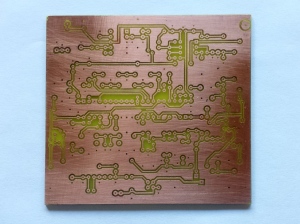 The plan is to use an Si5351a as the VFO and an Arduino Nano as the controller for display and selector. After some sizing of an 80m antenna the decision was made to change it to a 40m radio. The Toko inductors sourced from Ebay had their primary capacitors removed and a resonance check with 33 pf in parallel worked out nicely at 7 MHz. This design is very similar to the MMR40 built some time back, although it lacks CW, the audio filter and has a slight improvement to the crystal filter. The board is a bit smaller than the MMR40 at 97 x 90mm.
The plan is to use an Si5351a as the VFO and an Arduino Nano as the controller for display and selector. After some sizing of an 80m antenna the decision was made to change it to a 40m radio. The Toko inductors sourced from Ebay had their primary capacitors removed and a resonance check with 33 pf in parallel worked out nicely at 7 MHz. This design is very similar to the MMR40 built some time back, although it lacks CW, the audio filter and has a slight improvement to the crystal filter. The board is a bit smaller than the MMR40 at 97 x 90mm. 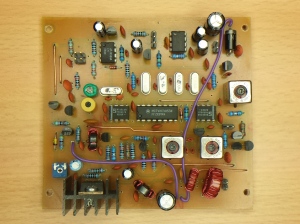 Some parts substitutions were made where components were not available or in the junk box:
Some parts substitutions were made where components were not available or in the junk box:
- 2N4401 substituted with 2N2222.
- 2N4403 substituted with BC557
- T37-2 toroid substituted with T-50-2 core and a couple of turns less.
- The PA uses low pass filter components from the MMR40.
- The 330pf cap across the mic amp feedback was reduced to 330pf as this caused too much audio rolloff in the MMR40.
- Crystal filter 9MHz crystals and BFO substituted with 10MHz crystals (LO change)
Next step is to get the digital board with the clock generator / VFO and display working. The VFO uses a Nokia 5110 display, Tocos TP9 Rotary Encoder, Si5351a board and an Arduino Nano. The software uses the Etherkit drivers for the Si5351a, (must order a board from Etherkit). The Adafruit Si5351a board was obtained from a local supplier conveniently. For the display, the drivers from RinkyDink Electronics are just what is needed. 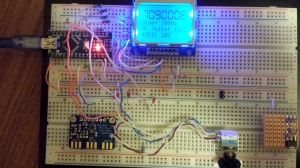 The software is working fine now, pressing the rotary encoder cycles through frequency steps and holding it down recalls a stored frequency. Now to decide on the mechanicals for the front panel. The controls and display will probably be on the top of the radio this time on one PCB with the VFO and controller.
The software is working fine now, pressing the rotary encoder cycles through frequency steps and holding it down recalls a stored frequency. Now to decide on the mechanicals for the front panel. The controls and display will probably be on the top of the radio this time on one PCB with the VFO and controller.
Update 2015-10-21: Finally had time to connect the VFO to the radio PCB and try it out. Strangely enough, it didn’t work first off! A bit of prodding around indicated that the FETs across the Toko RF input transformer were shutting off the RX signal. This was due to the PNP TX volts switch having an emitter to collector short. No idea why, replaced the transistor and the FETs were doing the right thing. Still no RX, but plenty of sensitivity in the 10MHz IF. The NE602 mixer was replaced and it sprung to life. This was a new NE602 too. Sensitivity is quite good, a 0.1uV signal is clearly discernable. Time to package up the VFO properly on a PCB with a lot of grounding.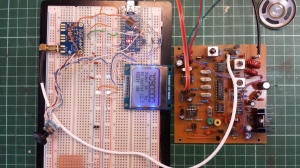 The pinouts of the arduino have been re-allocated to suit and easy pcb layout. Wasn’t much evidence of processor noise on the receiver. This time a case for the radio is made from PCB material soldered together. This was kind of inspired by Dave Richards’ amazing PCB radio chassis constructions. It’s nowhere as neat as Dave’s work, but so far seems quite strong and lightweight. Bracing it will be the key.
The pinouts of the arduino have been re-allocated to suit and easy pcb layout. Wasn’t much evidence of processor noise on the receiver. This time a case for the radio is made from PCB material soldered together. This was kind of inspired by Dave Richards’ amazing PCB radio chassis constructions. It’s nowhere as neat as Dave’s work, but so far seems quite strong and lightweight. Bracing it will be the key.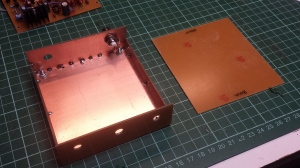
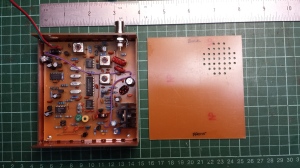 The PCB material was polished and lacquered before joining it all together. The outside of the enclosure will be cleaned up and painted.
The PCB material was polished and lacquered before joining it all together. The outside of the enclosure will be cleaned up and painted.
The Si5351a VFO will be mounted to the underside of the lid.
After the board was layed out, an error was found on the connections to the Si5351a module. This was due to the Eagle Nano part from the web that had port A reversed. The pinouts, not port numbers are correct in the schematic below.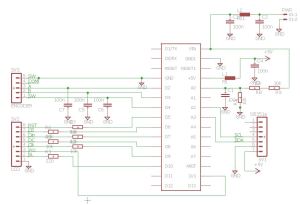
The VFO controller board came out fairly well. The component side is all ground plane and tracks on the solder side.
The VFO controller board sits alongside the display module under the lid.
It’s tight between the PCBs when the box is together. Not a lot of room between some of the taller parts on each PCB.
The VFO controller board PCB could have been made tighter using SMD parts although the modules use up most of the space. An Arduino Pro Mini would have saved a bit of space and left more clearance between the front panel encoder and the Nano USB socket.
Need a better way of mounting the speaker!
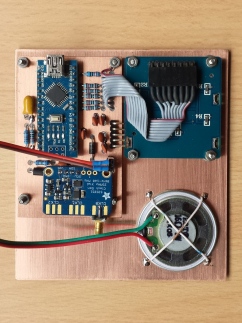
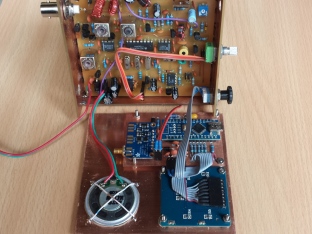 Testing out the fit before the sides of the top lid go on.
Testing out the fit before the sides of the top lid go on.
2015-11-07: Well its all going now and packaged up. It had a problem with low output and instability. Comparing the PA output toroid with the MMR40, the configuration was different. The MMR40 stepped the impedance down to the filter while this SSB1 design stepped the impedance up. I swapped over the toroid to the same configuration as the MMR40 and it was stable with expected output.
The only thing left now is to label the case and do some work on the software to time out the backlight and a few other tidy ups. The transceiver weighs only 273 grams compared to the MMR40 450 grams. Most of the weight saving is due to the PCB chassis rather than aluminium. The PCB chassis feels strong enough for the rigors of the field.
The photo on the left shows the size of the MMR40 compared with the SSB1. There is quite a difference. In addition, the power consumption of the SSB1 is lower at 50mA on receive. That could be improved using a switching regulator for the 5V / 3.3V supply.
The photo below shows the insides with the VFO / Controller under the top lid and the transceiver in the base. An 8dB pad for the VFO is under the transceiver board.
2015-11-21: The carrier suppression was not too good at around 15dB or so. This was fixed by placing a 500k trimpot between pins 1 and 2 of the NE602 balanced mixer with the slider of the trimpot connected to ground (pin 3).
The carrier nulled out with at least 25dB suppression.
There was a trace of RF instability in the PA when the voltage was around 14V under some conditions. This took a while to fix as it only appeared when the RF board was installed in the case. It was eventually cured with wire bridges across the ground plane over a few long tracks around the PA. RF output is a bit down on expected at 4W @14V. Something to look at later.
The crystal filter response was plotted and it isn’t that bad. A BFO offset of 2500Hz was needed so that the the LSB 300Hz frequency response was 3dB down the slope of the crystal filter. There is a dip of 3dB at 1600Hz and it falls away at 2800Hz. The response was measured using a signal generator into the antenna with a Digital Scope connected to the volume control hot side.

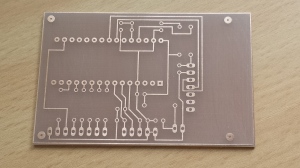
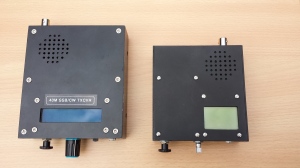
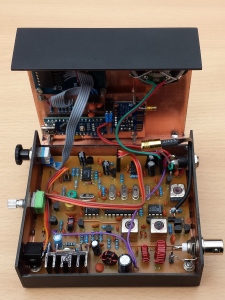
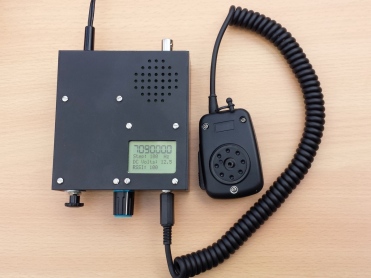
Hi Glenn, good luck building the 80m QRP rig. I will follow this post with interest. 🙂
Hi Glenn, you are setting yourself quite a challenge, and I don’t mean building the kit, but antennas for portable use on 80m are really awkward to manage. I think 80m is a great idea and I wished I had 80m antenna capability while I was in the Riverland. I have a 80/40m trapped dipole and I have used it portable: but it is heavy and too difficult to use. It is ok for a week of camping in the one spot. The best I have seen to date is the SOTA beams 80m antenna, but they are a bit expensive against the UK Pound.
I will watch with interest.
Cheers
John D
VK5BJE
Hi John, I do see what you mean. On the weekend, I rolled out an extra 20m (10m + 10m) to add to the switched dipole and think it will be unsuitable for most summits. Am now thinking about changing the rig for 20m! Cheers,
Glenn
Pingback: The New 40m QRP Rig Lives! | VK3YY
More great work Glenn. I had a look at the KD1JV SSB1 circuit and I like the way he uses just 2 602s, electronically switched between balanced modulator/product detector and tx/rx mixer. Simple, and saves parts. Peter VK3YE outlines this approach (not sure who came up with it) in one of his vids. Surprising that your 602 was DOA. I also like the AA7EE PCB cases. You need to be able to cut straight — did you guillotine or use another method? I am currently trying to tune up a VK3XU Twin Crystal Filter transmit strip. The receiver strip is here. https://vk3hn.wordpress.com/2015/08/17/tcf-does-rd-homebrew-7mhz-ssb-superhet/
I will write it up when it is all working and boxed up.
Hi Paul,
Yes, the DOA 602 was odd, guess they were Ebay grey market devices. The electronically switched filter works well. For the PCB, I just scribed the cutting lines and cut with a hacksaw and cleaned up with a file. A guillotine would be best, I used to have access to one and it did a very clean and straight cut. I have seen metalwork bench shears on Ebay cheaply, not sure how they would go though. Look forward to reading your write up on the on the strips!
That’s a cracking looking little rig there Glenn – and a mighty fine PCB enclosure too!
73,
Dave
AA7EE
Thanks Dave!!
Glenn, a pleasant surprise last night to have you come back to my CQ (on my homebrew 40 meter QRP SSB) presumably on this radio. A couple of watts at both ends. Great stuff! Your fabrication skills are impressive. There are many questions I could ask but will leave it to another on air QSO sometime. 73 Paul vk3hn.
Hi Paul, thanks for the homebrew QRP QRP contact! I was experimenting with carrier oscillator and filter on the rig when I heard you call, so it was a good test! Thanks for the comments. The switch mode regulator for the other HB backpacking rig was posted on the blog page. Cheers, Glenn.
Pingback: Ebay Solar Charger | VK3YY
Pingback: Transceiver for Backpacking | VK3YY
Hi Glenn,
Very nice project.
I would like to use the same DDS (SI5351 + Arduino Nano + Nokia display) on my KN-Q7A kit.
Can you send me your software for the Arduino? I am not so good at programming.
My email is vladmicu13 at yahoo.com
Many thanks,
Vlad YO3IHG
http://yo3ihg.blogspot.com/
Pingback: Light weight SOTA Stations | VK3YY
Pingback: HF1 QRP Transceiver Project | VK3YY
Pingback: BITX40 V3 and Raduino | VK3YY
I echo the request of Vlad. Possible to share your sketch? I am still in the analog world largely.
I have sent it …
.Good evening. I´m another guy who is interested in your sketch…would you share with me, please? 73
Hi Daniel,
Copy sent.
Hii pcb siprint pls
Hi, I´m interested in your sketch. Would you share with me, please?
73 Sebastian
sp3tlu@gmail.com
Hi, I´m interested in your sketch. Would you share with me, please?
73 Sebastian sp3tlu(at)gmail.com